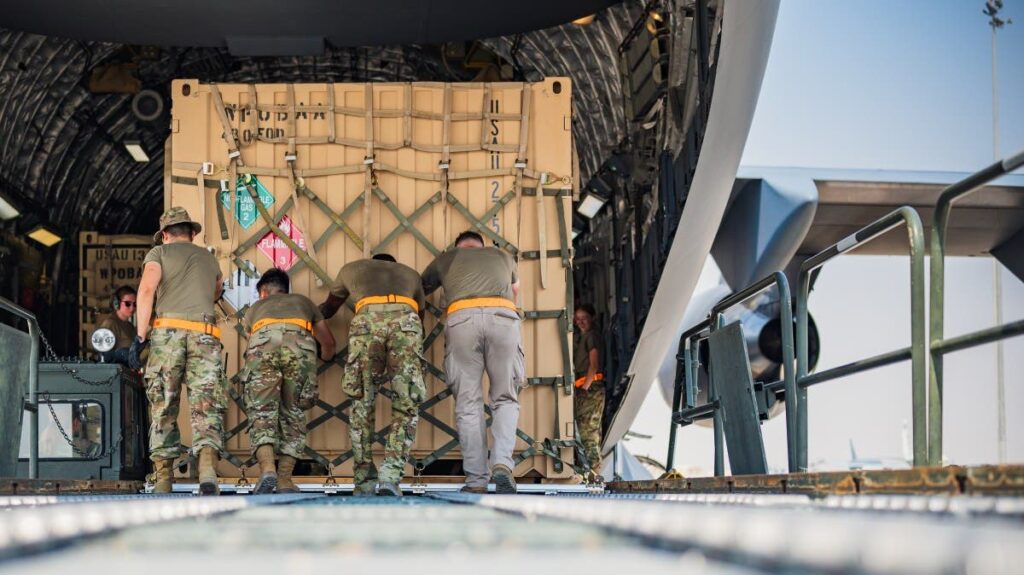The United States has spent more than $30 billion on the war in Gaza and associated conflicts in the Middle East, with more than half of this figure devoted to military support for Israel, a new report shared with Newsweek has found.
The study, released early Tuesday to mark the two-year anniversary of the Hamas-led attack on Israel that sparked the still-ongoing conflict, was overseen by the Costs of War project at Brown University’s Watson Institute for International and Public Affairs. While the scale of death and destruction emanating from the war has captivated audiences across the globe, the findings reveal a lesser-known yet significant cost to U.S. taxpayers.
Between October 2023 and September 2025, the U.S. devoted $21.7 billion in military aid to its top Middle East ally, Israel, while an additional range of $9.65−$12.07 billion has been spent by the U.S. on operations conducted in Yemen, Iran and elsewhere in the region in relation to the spillover of the conflict.
Altogether, the final figure is estimated to be between $31.35 billion and $33.77 billion, excluding additional sales still slated for Israel, which has already witnessed a historic increase in U.S. military assistance at the onset of the conflict.
“In a normal year, Israel would get $3.8 billion in U.S. military aid, pursuant to a 10-year agreement reached during the Obama administration,” William Hartung, co-author of the Costs of War report and senior research fellow at the Quincy Institute for Responsible Statecraft, told Newsweek.
“In the first year of the Gaza war, that figure skyrocketed to $17.9 billion, the highest level ever,” he added. “The second year of the Gaza war reverted back to the usual $3.8 billion. This was partially because the flood of aid for the prior year will be spread over a number of years, meaning that some of it could be used to finance the second year of the Gaza war.”
A Divisive Debate
On October 7, 2023, Hamas and allied Palestinian factions launched a surprise attack against Israel, killing around 1,200 people and taking around 250 more hostage, according to Israeli officials. Israel responded by launching its largest-scale war in Gaza to date, resulting in the deaths of more than 64,000 people in the Palestinian territory.
The conflict is the longest and deadliest of its kind for both sides and quickly spread across the region as factions of the Iran-led Axis of Resistance joined the fray in support of Hamas from Lebanon, Iraq, Syria and Yemen. Israel and Iran have also clashed directly on three occasions, the latest and most intensive of which erupted in June, with the United States also conducting strikes on Iranian nuclear sites as part of what President Donald Trump has called the “12-Day War.”
Although both Trump’s administration and President Joe Biden’s before him have largely backed Israel throughout the conflict, recent polling shows that views of the U.S. public have shifted significantly since the war began.
A New York Times/Siena survey published last week shows that, while 47 percent of respondents said they sympathized more with Israel than Palestinians in the immediate aftermath of the Hamas-led assault two years ago, that figure has now dropped to 34 percent, with 36 percent more sympathetic to Palestinians. The poll also found that a slight majority of 51 percent oppose providing additional economic and military support to Israel.
The trend has been accompanied by a growing international outcry and persistent protests in the U.S. over allegations of Israeli war crimes, including the targeting of civilians and the withholding of aid to Gaza. Israeli officials deny any systematic violations of international law and assert that Hamas routinely used noncombatants as human shields and smuggled humanitarian assistance, accusations denied by the militant group.
Hartung was among those who have criticized Israeli actions throughout the war, as well as the sharp increase in U.S. military spending associated with the regional conflict.
“Recent U.S. aid does not serve U.S. interests,” Hartung said. “The bulk of it has gone into enabling Israeli attacks on Gaza, which are disproportionate to aggression by Hamas and will create enmity towards the U.S. in the Middle East and beyond for years to come, complicating our ability to get support on other issues.”
“And other than missile defense systems, additional U.S. support has gone into attacks in the region like the bombing of Iran, which are more likely to spur retaliation and escalation than stabilize the region,” he added. “This is different from decades ago when U.S. aid was focused on deterring Arab states from attacking Israel, as they had done int 1967 and 1973.”
Newsweek reached out to the Israeli Consulate General in New York and the U.S. State Department for comment.
Direct U.S. Involvement
U.S. intervention in the Middle East has tested Trump’s electoral promise to avoid costly U.S. military endeavors abroad and oversee a more peaceful international order.
In addition to defending Israel against Iranian attacks and striking three Iranian nuclear sites in an unprecedented operation in June, the U.S. has also targeted Yemen’s Ansar Allah, also known as the Houthis, and the Islamic Resistance in Iraq throughout the conflict. Attacks against Iraqi militias largely ceased last summer following an unofficial truce under the Biden administration, while Trump announced a ceasefire with Ansar Allah in May that temporarily halted the group’s attacks on international shipping.
Operations against Iran and its Ansar Allah ally were particularly expensive. The Costs of War report found that both foes and their weapons were targeted with hundreds of multimillion-dollar munitions fired from even pricier platforms such as the $70 million F/A-18 Hornet, three of which were lost amid the battle with Ansar Allah.
Media reports have also indicated that the extensive use of interceptors, both those fired directly by the U.S. and others transferred to Israel, has substantially depleted the Pentagon’s supplies. Meanwhile, the U.S. continues to pledge arms shipments to partners on other fronts, including Ukraine in the midst of Russia’s ongoing war, and Taiwan, which is claimed by top U.S. geopolitical rival China, threatening additional stockpile strains.
Linda Bilmes, a senior lecturer at Harvard University’s Kennedy School, who co-authored the Costs of War report with Hartung, argued in her conclusion that her work was motivated by an effort to inform the U.S. public about the scale of funds devoted by the U.S. to conflict in the Middle East.
“The American public has a right to know how U.S. funding is used in conflict, and to recognize that U.S. military activities in the Middle East carry significant financial costs for taxpayers,” Bilmes wrote. “These costs are often hidden and should be weighed alongside how well they advance the goal of peace in the region.”
She also noted that “the full budgetary impact is likely to increase as replacement and sustainment requirements mature,” meaning that “the fiscal burden is substantial and should be material to discussions on U.S. policy.”

Prospects for Peace
The second anniversary of the devastating conflict comes amid renewed hopes for peace following a 20-point proposal unveiled last week by the White House that would result in a permanent end to the conflict, the release of hostages and prisoners, an Israeli withdrawal from Gaza and the replacement of the territory’s Hamas-led government with an independent committee comprised of Palestinian experts and led by Trump, among other conditions.
The plan was met on Friday with a positive response from Hamas that Trump characterized as indicating the group was “ready for lasting peace.” He called on Israel to “immediately stop the bombing of Gaza” and, on Sunday, reported “very successful” talks among the parties and mediators.
White House press secretary Karoline Leavitt confirmed Monday that “technical talks” were currently underway in Egypt as the administration “is working very to move the ball forward.”
Yet U.S. regional commitments may only grow even in a postwar scenario. Trump’s recent decision to guarantee Qatar’s security after the nation that hosts the largest U.S. base in the Middle East was struck by both Iran and Israel in the past four months has raised questions about the extent to which Washington was adding to its existing posture in the Arabian Peninsula.
The U.S. also continues to conduct strikes against Islamic State militant group (ISIS) targets in Iraq and Syria, where recent clashes between the interim government and the U.S.-backed Syrian Democratic Forces mark another challenge for U.S. policy in the region.
And should the precarious Israel-Hamas peace process once again unravel, as it has on many past occasions, Trump emphasized Sunday on Truth Social that the alternative would be escalation.
Trump wrote: “TIME IS OF THE ESSENCE OR, MASSIVE BLOODSHED WILL FOLLOW — SOMETHING THAT NOBODY WANTS TO SEE!”
Read the full article here

